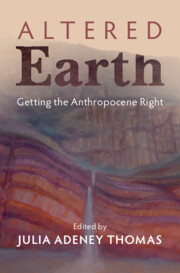Book contents
- Altered Earth
- Altered Earth
- Copyright page
- Dedication
- Contents
- Figures
- Foreword
- Acknowledgments
- Introduction: The Growing Anthropocene Consensus
- Part One Strata and Stories
- Chapter 1 Science: Old and New Patterns of the Anthropocene
- Chapter 2 Humanities and Social Sciences: Human Stories and the Anthropocene Earth System
- Part Two One Anthropocene; Many Stories
- Part Three Future Habitations
- Biographies of Chapter Contributors
- Index
- References
Chapter 1 - Science: Old and New Patterns of the Anthropocene
from Part One - Strata and Stories
Published online by Cambridge University Press: 24 March 2022
- Altered Earth
- Altered Earth
- Copyright page
- Dedication
- Contents
- Figures
- Foreword
- Acknowledgments
- Introduction: The Growing Anthropocene Consensus
- Part One Strata and Stories
- Chapter 1 Science: Old and New Patterns of the Anthropocene
- Chapter 2 Humanities and Social Sciences: Human Stories and the Anthropocene Earth System
- Part Two One Anthropocene; Many Stories
- Part Three Future Habitations
- Biographies of Chapter Contributors
- Index
- References
Summary
The Anthropocene concept was developed by Nobel laureate Paul Crutzen beginning in 2000 to reflect the realisation that human impacts had pushed Earth outside of the stable conditions of the Holocene Epoch. It quickly became a framing concept for the Earth System science community, with subsequent, ongoing analysis as a potential addition to the Geological Time Scale unit by geostratigraphers. The term's use then spreading widely to other disciplines. The Anthropocene may be described via striking, partly irreversible changes to the Earth’s physical surface (‘lithostratigraphic’), to its surface chemistry (‘chemostratigraphic’) and to its biology (‘biostratigraphic’). Its beginning is best placed around the mid-twentieth century at the same time as the sharp change in Earth System trajectory, driven by an expanding technosphere. Time will tell whether it becomes formalized, but its geological reality as the beginning of a major new chapter in Earth history is now beyond doubt.
- Type
- Chapter
- Information
- Altered EarthGetting the Anthropocene Right, pp. 21 - 50Publisher: Cambridge University PressPrint publication year: 2022

